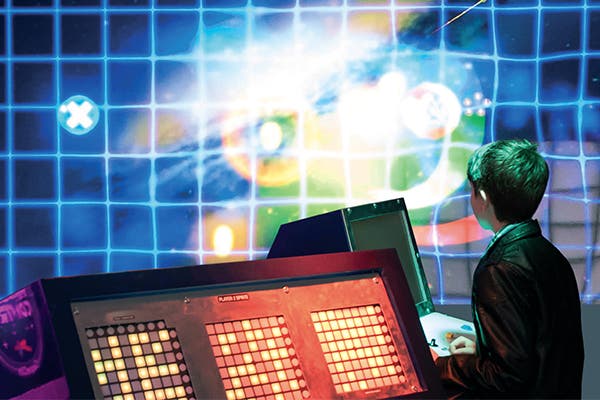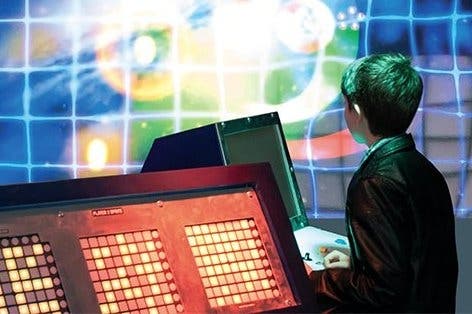Exploring a very different kind of arcade
A day in the National Videogame Arcade.
It's not where you'd expect to find a place like this. Nottingham's more famous for Robin Hood and Su Pollard than video games, but that's been changing over the past ten years thanks largely to Gamecity, a festival started by Iain Simon. Gamecity is a unique celebration of video games that takes over the city, and has one guiding ethos: everybody should be able to play, see and discover games for themselves.
The National Videogame Arcade sees this ethos embedded in bricks and mortar, a five storey shrine to all that's great and good about the medium. I travelled to Nottingham to take a look around, and spoke to Jonathan Smith, the venue's co-director. "One of the reasons we love games is because they're always giving us new things," he tells me. "As a creator you become very interested in novelty and exploring things people haven't done yet. A permanent building, a cathedral dedicated to video games was something nobody had done yet, at least not in the UK, and as I got talking with Iain over the past few years, it seemed an opportunity with a gravitational force that was irresistible."

This isn't like the arcades of your youth, for sure - there are less cigarette butts lying around, for one thing - although there's still plenty that's comfortingly familiar. In one corner, taking pride of place near the entrance, there's a stand up 4-player Teenage Mutant Ninja Turtles cabinet. Dibs on Donatello. It's all part of a unique space, very open and clean. "We didn't want this to be something niche tucked away," explains Smith. "We wanted a place you could explore, it had to have secrets and it had to be grand, in the romantic sense. You needed to get lost in it." The building itself was once a lace factory, where art and technology once collided in another fashion, and its large showrooms with smaller offices and narrow hallways invite you to explore them.
Another of the first exhibits is Mission Control and it's a doozy, taking over an entire room with giant ominous computer consoles that create a scene like something from a 60s sci-fi movie. The game itself is only for two players, but those spectacular control panels allow ten other players to tinker with the game on the fly. "We wanted to make a game that could be edited while being played in order to explain the component parts of a game, from code to audio to graphics," says Smith. "This gives people from the start the experience of being a game creator, we're not interested in creating new consumers, we want to create new creators."
This appropriately playful attitude to the exhibits is apparent throughout the building, and by combining these one off interactive pieces alongside more traditional arcade machines and video game consoles, the National Videogame Arcade manages to walk that tightrope of honouring the existing tradition of games while encouraging new people to get involved. This was perfectly exemplified in the Jump! exhibit which took over the entirety of Gallery 2 when I visited. A plethora of games were dotted around the exhibition space to illustrate this fundamental game mechanic, from Super Mario Brothers to Rocket League, but there were also brand new creations. One of the most striking was an old repurposed Victorian cabinet named the Jump-O-Tron! Smith explains its working with the same feverish excitement as a kid telling you about the best thing he saw that day. What is it that makes the perfect jump? "The perfect jump," he answers, "is the one that makes you laugh the most." Like Mission Control, the Jump-o-Tron was a bespoke creation designed by the in-house team at the National Videogame Arcade. "The number one thing we wanted to avoid was blue screens or out of order signs," says Smith. "We wanted to build and maintain everything in house rather than buying anything in." This means that rather than have the usual museum staff of curators and archivists, the venue is staffed by technicians and software engineers and game designers. "It allows us to always be on top of things, but crucially we're also able to explain how everything works and how it was made."

The National Videogame Arcade does a grand job of challenging preconceptions, too - there's a spin on Sonic's Green Hill Zone that has you controlling the camera rather than Sega's mascot, while a more traditional museum section helps educate you of the more esoteric history of the medium. There's Nim, which was shown off at London's National Exhibition in 1951, home-made tape covers for pirated C64 games and a copy of the original review disc for Grand Theft Auto. Wonderful museum pieces, all of them, but you sense they don't quite get to the heart of what this place is about. "We've been very lucky with people donating things," says Smith, "but ultimately, old things break. We've got through a BBC, a Spectrum, C64, a CPC lasted two days but we did have our first ever tape loaded game on the floor. We really want everything to be playable by people, but we are aware that many of the rarest and most precious are the ones we would least have people be able to play. We actually have a Magnavox Odyssey in excellent condition but it's one of the least impactful things here, it's just in a glass case."
The National Videogame Arcade is at its best when it's hands-on, and when it's pushing games into interesting spaces. It's been used for workshops, masterclasses and even as a venue to stage a Super Mario musical. Even better, it's become the ideal venue for birthday parties. "So in the lounge we have 2 projector screens and 25 networked computers running Minecraft together," says Smith. "If you're 10 or 11, and Minecraft starts to play on the projectors, your parents watching from the back, your birthday cake is waiting and we start the countdown to our specially designed Hunger Games map, you are having a pretty good day.
There was no cake, but I had a pretty good day myself. As I leave I notice the Teenage Mutant Ninja Turtles cabinet again. That same game I got lost in as a kid playing with friends, bragging about scores in the playground the next week. Back then my parents would have been horrified if they saw the murky pool halls I'd go to in order to have another play of the game. Here, though, in the National Videogame Arcade, it is given a pedestal. Change the context and you change the perception. Everybody should be able to play and explore, and the National Videogame Arcade fulfils this ethos with aplomb.








